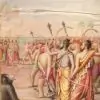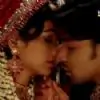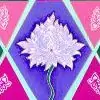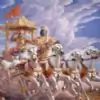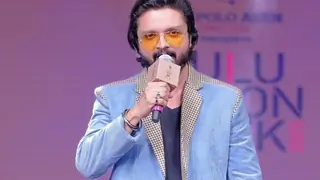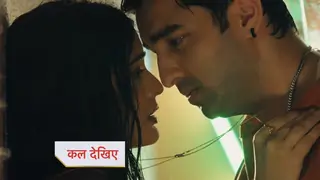Originally posted by: Chandraketu
In San Francisco, there is a Vedanta Society office, and there, they have a bookstore that has a lot of books on the Ramayan. However, I haven't seen a book that has the original Valmiki Ramayan, w/ original Sanskrit verse, transliterated words w/ meanings, and then translation.[/quote]
That's a tall order. 😆 Seriously yes, it would be ideal if there were a book in that form.
Since I am in the mood, let me give a short lecture. 🤓 😆
I hope you guys are aware that there are multiple versions of the Valmiki text. Many different manuscripts are available. In general, the text has come down to us in two major recensions: the Northern and the Southern. The Northern recension is further split into the Norther-Eastern/Gaudian and the North-Western recensions. The most popular Southern recension is also known as the "vulgate". Some scholars are of the opinion that there is an independent Western recension but the manuscript evidence for this is debatable.
Each recension and subrecension consists of multiple manuscripts and these manuscripts are in different scripts e.g. Sarada, Maithili, Bangla, Nepali, Grantha, Telugu, Malayalam, Devanagari. Some manuscripts are complete while others are not. There are also many commentaries written over the centuries. These commentaries are very useful in analyzing the Ramayana manuscripts in terms of pin pointing the meanings, context, interpolations, etc. Some commentaries remain unpublished by the way.
Most of the Ramayana books that you find are based on the vulgate Southern recension, because it remains the most popular one.
Here is a list of important Sanskrit editions (yes I know you are looking for translations but I think it is important to be aware of the Sanskrit text editions):
- Ramayana of Valmiki - critically edited North Western recension. Seven Volumes. Lahore: D.A.V. College Sanskrit Series. Edited by Vishva Bandhu Shastri & Bhagvat Datta.
- Valmiki Ramayanam - North Eastern/Gaudian recension. Edited by Narendachandra Bhattacharya & Amareswar Thakur. Calcutta: Metropolitan Publishing House (Calcutta Sanskrit Series), 1932. Seven Volumes.
- Ramayanam - Critically edited Southern Recension, by Narayana Swamy Aiyar, 1933. Two volumes.
- Ramayana of Valmiki - This is the so-called "vulgate" text. Bombay, Gujarat Printing Press (1914-1920). Seven Volumes. Includes the Tilaka, Siromani and Bhusana commentaries.
- The Valmiki Ramayan: Critical Edition (1960-1975) - edited by G.H. Bhatt et al. Seven volumes. Baroda: Oriental Institute.
As far as the Western recension is concerned, it is disputed whether such a classification is correct or not. I don't think there are any Sanskrit publications identified as a purely Western text. I only know of a Bangla translation that is supposedly based on the Western recension. It is
Valmiki Ramayana, translated by Tarakanta Bhattacharya, Calcutta, 1928.
The Critical Edition (5th in the above list) is one of the most important editions of the text available. It was the product of painstaking work wherein all manuscripts were studied in order to produce an authentic version. It is not without its flaws however. Over the years the methods they used have come under criticism and debate. The basic assumption they used is that the Southern Recension is the least distorted version (given the largely homogenous nature of the manuscripts). Consequently it is similar to the vulgate but shorter since a lot of verses have been removed due to various reasons. And it is these methods of deciding which verses to keep and which to remove that are hotly debated.
Some choices were made based purely on the number/distribution of supporting manuscripts regardless of whether it makes contextual or syntactic sense. Sometimes the inclusion of a sarga actually creates contextual problems but it was still kept due to scriptural evidence. The basic principle (any verse without significant support from all recensions was to be removed) was sometimes ignored creating further controversy.
Despite its flaws however, the Critical Edition is of immense academic value. As I mentioned above, it is based on analysis of ALL manuscripts available which makes it a great source for Ramayana research. The additional notes, appendices, lists,etc provided are of immense value. No student of the Ramayana should ignore this version.
Strangely enough, there is only one English translation of the Critical Edition available:
The Ramayana of Valmiki: An Epic of Ancient India. It is being published by the Princeton University Press. It is a collaboration between five American Scholars (Robert P. Goldman et al). The work started in the mid 1980s and is now nearing completion. I cannot stress the importance of this enough. For one, it opens up the Critical Edition to a lot of people. Second, they translated sloka-by-sloka. There is no abridgement. Each book has 3 sections. Part I provides background information on the Critical Edition, commentaries used, annotations, analysis of the text and the methods used in translation, literary and historical aspects, analysis of the characters, story, etc. Part 2 is the actual translation itself. Part 3 is the "Notes" section where extensive notes are provided on a sarga-by-sarga and sloka-by-sloka basis. In cases where they had to make difficult choices (due to the inconsistencies of the Critical Edition because of the problems in their methods I mentioned above), they provide the full reasoning behind their final decisions. In cases where a literal translation did not seem to fit well and they had to compromise a bit, the full literal translation is provided in the notes.
There are detailed glossaries, bibliographies and notes on any corrections they had to make to the critical edition.
I strongly urge people to get this version. The first 5 volumes were finished by the late 1990s. The remaining two are being published this year.
Here are the Princeton University Press listings of this work. The publication date for Book 6 is Sept 2009.
For some reason, Book 7 hasn't shown up on the Princeton University Press website but it is listed on Barnes & Noble with a date of May 2009.
The first 5 volumes are also available at various libraries in USA/Canada.
The Princeton University Press publications do not provide the Sanskrit text or transliteration.
New York University is publishing the same translation as part of their Clay Sanskrit Library series (scroll down to find them). The Clay Sanskrit books are smaller in size and don't have any of the background material, discussions or the extensive notes but it does provide transliterations of the Sanskrit text (transliteration on the left-hand page and translation on the right-hand page).
Sacred Texts has provided the full Ralph T. H. Griffith translation online. It is based on the Northern recension (I am not sure exactly which subrecension). It is from the 1870s. Quite difficult to read archaic Victorian English. I'm just mentioning it here since is a freely available complete text.
Other English translations and some comments:
- Ramayana of Valmiki - Manmatha Natha Dutt, edited and revised by Dr. Ravi Prakash Arya. Four volumes. The original translation of M.N. Dutt was published in the late 19th century but it has now beeng completely revised and edited by Dr. Arya in 1998. The archaic Victorian English has been transformed into modern English. Dr. Arya has provided his own translations in some places. This is based on the Vulgate Southern text using the Tilaka, Amrtakataka and Tika (Ramanuja) commentaries. The original Sanskrit verses (in Devanagari) are also provided.
- Srimad Valmiki Ramayana - The Gita Press Edition, Gorakhpur, 1974. Two volumes (1969, 3 volumes). This is also based on the Vulgate and the commentaries mentioned above. Please take note: Gita Press also incorporates many interpretations (based largely on the Tilaka commentary) into the translation itself.
- The Ramayana of Valmiki - Hari Prasad Shastri. London: Shanti Sadan, 1957 (2nd edition, 1969). Three volumes. Also based on the vulgate and commentaries mentioned above for the M. N. Dutt translation.
- Srimad Valmiki Ramayana - N. Raghunathan, 1981. Madras: Vighneswara Publishing House. Three volumes. Based on Southern text using the Bhusana, Tattvadipika and Tika commentaries.
These seem predominantly based on the Southern Recension with some mixing going on at various places.
For a condensed version, I recommend
The Ramayana of Valmiki by P. Lal, New Delhi, Vikas Publishing House, 1981.
You know, it is a great tragedy that no one has done for the Ramayana what Padma Shri Prof. P. Lal did for the Mahabharata. For those who are not aware, I am referring to the well known scholar, teacher, poet, author, translator, essayist and publisher, Padma Shri Prof. Purushottam Lal, Jawaharlal Nehru Fellow, Distinguished Visiting Professor at several universities in USA and honorary Professor of English at St. Xavier's College, Calcutta. He started a Mahabharata translation project in the 1970s, although he prefers to call it a "transcreation". This is a sloka-by-sloka transcreation of the entire Mahabharata using all slokas in all recensions, making it
the most complete version of the Mahabharata available in any language. The importance of this work cannot be overstated! It was originally published in 338 fascicules but is now being collected into 18 volumes corresponding to the 18 parvas of the text. Sixteen volumes are available. Now don't expect the original Sanskrit text as well. Remember, he used all recensions. So if he had to provide the original text then the book would be overflowing with Sanskrit in various scripts (Devanagari was not the only script used for Sanskrit in history, as I have mentioned in another thread). 😆 Maybe some day someone will do that as well. 😉
It is available from
Writers Workshop, a publication house founded by P. Lal.
Some day I hope someone will do the same thing for the Valmiki Ramayana: a complete sloka-by-sloka transcreation using all slokas of all recensions. 😊
Edited by Kal El - 16 years ago


